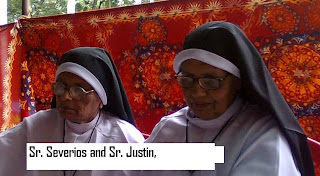
Nuns' tale: Kerala style
There was a time when every Catholic family in Kerala dedicated at least one child from each gender to the Lord. In this matter every family prided as well. Sometimes this went to the extent of sending all except one to the seminary or the convent. The last one son was supposed to remain in the ancestral home looking after the aged parents and also other siblings who for some reason or the other were not married nor had their own independent existence. The family found a place for everyone even the weakest or the quaint and unconventional.
Here are two of my aunties, my dad's fourth and fifth sisters out of a total of nine children. Having as many children was a blessing and a matter of pride. It is interesting to note the transition in fashion spanning almost half a decade in the first half of the 20th century. Thus the names of the children were Mariakkutty, Elikkutty, Thresiakutty, Lily, Gracy, Ritamma, Jose, Mercy and George. The first three had the affectionate kutty as an appendix for christian women and also the first part was heavily localised with a heavy 'rr' in Maria (Mary), Eli (for Elizabeth) and Thressia (malayalised for Tresa) all names reminiscent of Christian saints but with Lily and Gracy this changed for Lily is a flower and Gracy is modification of grace. Ritamma is obvously the lcoalised version of Rita with an affectionate 'amma' (mother or merely woman), Jose is a fashionable contraction of Joseph or Ouseph (localised for Joseph), Mercy and George definitely fashionable for the times. Even Goerge is a heavily anglicised version of Geevarghese.
Among these the fourth and the fifth ones Lily and Gracy joined the FCC, Franciscan Clarist Convent at Teekoy. The elder one joined,but when she was to leave, the younger one declared she was also leaving to become a nun to everyone's surprise. So the story goes. At a later stage Mercy also decided to leave and did leave but my father on leave from the Air Force promptly went to take her back from the convent saying she was not nun stuff.
For the self proclaimed social scientist in me the leaving of the girls to the convent apart from the call to vocation also indicated the financial position of the family like the rings on a tree reveals the weather and climate of the times,
Grandfather may have found it increasingly expensive to marry off the first three girls but the next in line may also have guessed the difficulty of the father and in order to ease things at home they may have prefered to be in the convent. Other stories from elsewhere in certain families reveal that the call to convent is actually after a repulsive experience of either the parents' own matrimony or that of an elder sister. I am not implying all vocations are having these reasons but such were not enitrely ruled out.
These two were teachers having done their TTC (Teachers' Training certificate) from Vazhakkulam, St. George's Teachers Training School.
Here again the circumstances of the locale influenced the calling. The third,fourth, fifth and the eighth child went to do TTC. The first two could not because the institute came later or even if it was there attitudes prevented girls taking up jobs outside. How the attitudes changed by the third daughter is a mystery for me. So was the attitude towards girls leaving for the nurse's job. Today it is considered prestigious to have a daughter nurse in Ireland or the Gulf.
The seventh child, my father went to the Air Force, the year being 1956, 11 years after the World War II. My conjecture is that the stories of the war were still in the air to make the military attractive for boys.
The other theory of mine is that there were only two options other than remaining in the homestead tending to agriculture. Be a teacher or bugger off to the military. The sixth one, a daughter was cut out for a housewife in a purely agricultural stead and she indeed was good at that where she was married off. By the time the ninth a boy reached 22, it was indeed different with Banks as a new option.
One out of two daughters of Ritamma also became a nun, sister Jain, nearly 50 now and a Principal in a school in the state of Orissa. It was her 25th year of ordination, and the picture of Lily(Sr. Severios) and Gracy (Sr. Justin) was on that occassion when the jubliee was celebrated.
The not so nuns
It is equally commendable the work of those who live like nuns with the nuns for many years. They toil in the kitchens, many of them imbibe the values, except that they dont take the vows of poverty, obedience and chastity. The picture here depicts not only them but also a vanishing dress mode traditionally of the Kerala Christians. Attractive in its simplicity and modesty these represent not only the Christian values of prudence and rectitude, but also a time when options in dress materials or fashions were non existent. To think that these can safely be construed as the attire of the Christians from the time of St. Thomas is at once mindbogling in that they are fast being replaced by the modern dress and herald the change and the immense velocity of change.






















No comments:
Post a Comment